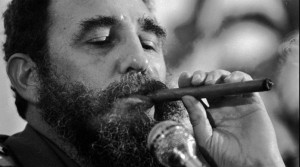10% off your first order
Free concierge design service :
(424) 226-8612
10% off your first order
Free concierge design service :
(424) 226-8612

 Cuban Migration
Cuban immigration largely depends on the political climate in Cuba. Since Cuba is relatively close to the United States, about 110 miles across the ocean, America was a good option for relocation. Fidel Castro, a Cuban dictator, rose to power in the late 1950s. This triggered the first wave of migration, which was from 1959-62. According to Pew Research Center, this first wave of immigrants was mostly upper and upper middle class families with higher-class professions. The United States and Cuban governments arranged the next wave from 1965 to 1974. This time, working and middle class Cubans had their turn to come to America, becoming known as the ?freedom flights.?
From April to October of 1980, many Cubans took advantage of a new announcement from the Cuban government stating that anyone who wanted to leave the country could. This triggered what has become knows as the Mariel boatlift, where about 125,000 Cubans settled in the United States. The last wave, which is still going on right now, began in 1989 after the collapse of Communism in Cuba.
Cuban Population in United States Today
Today about 1.5 millions Cubans reside in the United States, with the vast majority of them living in Florida. Of the Cubans in Florida, 70 percent were born in Cuba. Cubans in the United States tend to be older than 25 years old, unlike the rest of the Hispanic population.
Cuisine
Cubans in America enjoy eating their native foods as well as the many other diverse food options that the United States has to offer. The Cuban cuisine has both Spanish and West African roots, reflecting Cuba?s population. The most common meats are pork and beef with rice, beans and root vegetables as side dishes. One such dish is called ?Ropa Vieja,? which is stewed shredded beef with various vegetables. It is often served with white rice. Cuba is also famous for their fried plantains, often served as a side dish.
Cuban sandwiches have also become increasingly popular in the United States. Two pieces of buttered bread filled with pork, ham, Swiss cheese, pickles and mustard grew out of the old flow between cigar workers between Cuba and Florida. This sandwich is often pressed to meld all of the unique flavors together.
Cuban desserts have a strong Spanish influence and often infuse guava into their sweet dishes. To make ?Casco de Guava? people boil the outer portion of the guava in sugar and lime juice. It is then served with cream cheese or some other form of soft white cheese. Other desserts such as flan (sweet custard), bunuelos (fried dough sprinkled with sugar and cinnamon), or tres leches cake (cake infused with three different types of milk), are very similar to those of other Hispanic countries but often have a little Cuban twist.
To drink, Cubans tend to enjoy typical American drinks as well as a few unique cocktails. The ?Cuba Libre? is a combination of rum and coca-cola topped with a squeeze of lemon. The ?Cubanito? combines several sauces such as Worcestershire sauce and hot sauce and is often used as an appetizer. Another drink is the ?Havana Loco,? made with Havana club and flavorful tropical fruits.
Cigars
Although cigars did not originate in Cuba, they quickly became a Cuban staple. When Fidel Castro rose to power, it started a trade embargo that limited Americans from obtaining Cuban cigars, which was Cuba?s most prized export. Cuba?s climate and land created a perfect place for the tobacco plant to thrive, causing many countries around the world to purchase Cuban cigars.
[caption id="attachment_727" align="alignnone" width="300"]
Cuban Migration
Cuban immigration largely depends on the political climate in Cuba. Since Cuba is relatively close to the United States, about 110 miles across the ocean, America was a good option for relocation. Fidel Castro, a Cuban dictator, rose to power in the late 1950s. This triggered the first wave of migration, which was from 1959-62. According to Pew Research Center, this first wave of immigrants was mostly upper and upper middle class families with higher-class professions. The United States and Cuban governments arranged the next wave from 1965 to 1974. This time, working and middle class Cubans had their turn to come to America, becoming known as the ?freedom flights.?
From April to October of 1980, many Cubans took advantage of a new announcement from the Cuban government stating that anyone who wanted to leave the country could. This triggered what has become knows as the Mariel boatlift, where about 125,000 Cubans settled in the United States. The last wave, which is still going on right now, began in 1989 after the collapse of Communism in Cuba.
Cuban Population in United States Today
Today about 1.5 millions Cubans reside in the United States, with the vast majority of them living in Florida. Of the Cubans in Florida, 70 percent were born in Cuba. Cubans in the United States tend to be older than 25 years old, unlike the rest of the Hispanic population.
Cuisine
Cubans in America enjoy eating their native foods as well as the many other diverse food options that the United States has to offer. The Cuban cuisine has both Spanish and West African roots, reflecting Cuba?s population. The most common meats are pork and beef with rice, beans and root vegetables as side dishes. One such dish is called ?Ropa Vieja,? which is stewed shredded beef with various vegetables. It is often served with white rice. Cuba is also famous for their fried plantains, often served as a side dish.
Cuban sandwiches have also become increasingly popular in the United States. Two pieces of buttered bread filled with pork, ham, Swiss cheese, pickles and mustard grew out of the old flow between cigar workers between Cuba and Florida. This sandwich is often pressed to meld all of the unique flavors together.
Cuban desserts have a strong Spanish influence and often infuse guava into their sweet dishes. To make ?Casco de Guava? people boil the outer portion of the guava in sugar and lime juice. It is then served with cream cheese or some other form of soft white cheese. Other desserts such as flan (sweet custard), bunuelos (fried dough sprinkled with sugar and cinnamon), or tres leches cake (cake infused with three different types of milk), are very similar to those of other Hispanic countries but often have a little Cuban twist.
To drink, Cubans tend to enjoy typical American drinks as well as a few unique cocktails. The ?Cuba Libre? is a combination of rum and coca-cola topped with a squeeze of lemon. The ?Cubanito? combines several sauces such as Worcestershire sauce and hot sauce and is often used as an appetizer. Another drink is the ?Havana Loco,? made with Havana club and flavorful tropical fruits.
Cigars
Although cigars did not originate in Cuba, they quickly became a Cuban staple. When Fidel Castro rose to power, it started a trade embargo that limited Americans from obtaining Cuban cigars, which was Cuba?s most prized export. Cuba?s climate and land created a perfect place for the tobacco plant to thrive, causing many countries around the world to purchase Cuban cigars.
[caption id="attachment_727" align="alignnone" width="300"] Cuban cigars are a staple in American society.[/caption]
Today in America Cuban cigars are a popular fixture, appearing in television shows and promoted by celebrities such as Arnold Schwarzenegger and Lil Wayne. In fact, Americans like Cuban cigars so much that they base many of their cigars off of the Cuban cigar flavors. For example, Custom Tobacco makes cigars with a similar profile to the Cuban Partagas. Custom Tobacco has even taken the idea of the Cuban cigar one step further, allowing people to customize the band on cigars for company events, parties or just for personal use.
Language
Although English is the most common language in the United States, the vast majority of Cubans tend to speak Spanish at home. However, Cubans born in America tend to speak English primarily and struggle more with Spanish than their family members that were born in Cuba. Since most Cubans that were born in America speak both languages, they often speak ?Spanglish,? or a linguistic combination of both.
Family Dynamic
Cuban American families tend to be less traditional than Cuban families. In Cuba, parents have a strong control over their children?s lives, and the father is the head of the household. In the United States, women play more of a part within the family because they contribute to the household?s income, independence and security. Children in the U.S. have greater independence from their parents. In Cuba, for example, most couples who are dating are accompanied by an adult chaperone. An adult, however, does not accompany Cuban American couples, most of the time.
Parents select godparents, or ?compadres,? to play a significant role in their child?s life. However, in America Godparents do not play as much of a role in their godchild?s life.
Religion
The majority of Cubans living in Cuba identify as Roman Catholic, while some identify as nonreligious. The antireligious bias of the socialist government in Cuba influenced the portion that is nonreligious. Cubans in the United States are overwhelmingly Roman Catholic. According to the Pew Research Center, 80 percent of Cubans born in Cuba and 68 percent of those born in the U.S. are Roman Catholic.
Santeria
Movies and American popular culture sometimes depict Cuban Americans as practicing ?Santeria? which is a form of ?black magic.? Most of these portrayals are inaccurate and negative. In actuality, the Santeria practice involves a combination of West African rituals and Roman Catholic saints which involves healing rituals, animal sacrifice and spirit possession. Recently a Miami Santeria churched challenged the law prohibiting animal sacrifice. The U.S. Supreme Court struck down their petition, causing the Santeria church to adapt their practices to U.S. law.
Employment
In the Miami area, where most Cuban Americans live, they are prominent in almost every profession. In the book Cuban Exiles in Florida: Their Presence and Contribution, the author Manuel Viamonte writes that there are about 2,000 Cuban American doctors in Miami. Compared to other Hispanic groups in the U.S., Cuban Americans are better off financially and about as well off as average Americans.
Cuban cigars are a staple in American society.[/caption]
Today in America Cuban cigars are a popular fixture, appearing in television shows and promoted by celebrities such as Arnold Schwarzenegger and Lil Wayne. In fact, Americans like Cuban cigars so much that they base many of their cigars off of the Cuban cigar flavors. For example, Custom Tobacco makes cigars with a similar profile to the Cuban Partagas. Custom Tobacco has even taken the idea of the Cuban cigar one step further, allowing people to customize the band on cigars for company events, parties or just for personal use.
Language
Although English is the most common language in the United States, the vast majority of Cubans tend to speak Spanish at home. However, Cubans born in America tend to speak English primarily and struggle more with Spanish than their family members that were born in Cuba. Since most Cubans that were born in America speak both languages, they often speak ?Spanglish,? or a linguistic combination of both.
Family Dynamic
Cuban American families tend to be less traditional than Cuban families. In Cuba, parents have a strong control over their children?s lives, and the father is the head of the household. In the United States, women play more of a part within the family because they contribute to the household?s income, independence and security. Children in the U.S. have greater independence from their parents. In Cuba, for example, most couples who are dating are accompanied by an adult chaperone. An adult, however, does not accompany Cuban American couples, most of the time.
Parents select godparents, or ?compadres,? to play a significant role in their child?s life. However, in America Godparents do not play as much of a role in their godchild?s life.
Religion
The majority of Cubans living in Cuba identify as Roman Catholic, while some identify as nonreligious. The antireligious bias of the socialist government in Cuba influenced the portion that is nonreligious. Cubans in the United States are overwhelmingly Roman Catholic. According to the Pew Research Center, 80 percent of Cubans born in Cuba and 68 percent of those born in the U.S. are Roman Catholic.
Santeria
Movies and American popular culture sometimes depict Cuban Americans as practicing ?Santeria? which is a form of ?black magic.? Most of these portrayals are inaccurate and negative. In actuality, the Santeria practice involves a combination of West African rituals and Roman Catholic saints which involves healing rituals, animal sacrifice and spirit possession. Recently a Miami Santeria churched challenged the law prohibiting animal sacrifice. The U.S. Supreme Court struck down their petition, causing the Santeria church to adapt their practices to U.S. law.
Employment
In the Miami area, where most Cuban Americans live, they are prominent in almost every profession. In the book Cuban Exiles in Florida: Their Presence and Contribution, the author Manuel Viamonte writes that there are about 2,000 Cuban American doctors in Miami. Compared to other Hispanic groups in the U.S., Cuban Americans are better off financially and about as well off as average Americans.
 Politics
According to the Pew Research Center, the amount of Cuban Americans who identify as Republican or Democrat is about the same. In recent years, several Cuban Americans have risen to prominence. Texan Senator Ted Cruz ran for president in 2016 as did Florida Senator Marco Rubio. Cuban Americans have also created the Cuban American National Foundation, one of the country?s strongest ethnic lobbies. Cuban Americans are also politically active, with 67 percent of them participating in the 2017 presidential vote.
Film and Television
Politics
According to the Pew Research Center, the amount of Cuban Americans who identify as Republican or Democrat is about the same. In recent years, several Cuban Americans have risen to prominence. Texan Senator Ted Cruz ran for president in 2016 as did Florida Senator Marco Rubio. Cuban Americans have also created the Cuban American National Foundation, one of the country?s strongest ethnic lobbies. Cuban Americans are also politically active, with 67 percent of them participating in the 2017 presidential vote.
Film and Television
 The 1950s hit television series ?I Love Lucy? featured Desi Arnaz, who was married to Lucille Ball in real life. Maria Conchita Alonso, who was born in Cuba, was nominated for a Grammy award for best single album. An actor in The Untouchables, Godfather III, When a Man Loves a Woman and Internal Affairs, Andy Garcia was nominated for an Oscar.
Music
Both Celia Cruz and Gloria Estefan are popular within the Cuban American community and in the general American public as well. Celia Cruz, also known as the ?Queen of Salsa,? sang songs such as ?La Negra Tiene Tumbao? and ?La Vida es un carnival? that were widely popular and gained recognition for the Latino community. Gloria Estefan was and still is widely known. Some of her greatest hits are ?Turn the Beat Around? and ?Get on Your Feet.?
Marielitos
Cuban Americans have faced some backlash from the idea that immigrants who came on the Mariel boatlift were criminals. Some of the descendants of immigrants who came to America on the Mariel boatlift formed gangs. These gangs, which were at their peak in the 1980s, were mostly involved in drug trafficking and contract killings. In some situations they aligned themselves with the Italian American Mafia families. Al Pacino played a Mariel refugee in the well-known film ?Scarface,? which caused more of a stigma against ?Marielitos.?
Broadcast and Print Publications
The Cuban American community has many of their own radio stations, news publications and television stations. There is WLTV-Channel 23 (Univision) and Channel 51 (Telemundo). The radio stations range from news and talk shows to contemporary music stations. The print publications include ?Cuba Update,? ?Hispanic Newsletter,? ?El Nuevo Herald? and ?El Nuevo Patria.? These newspapers allow Cuban Americans to have a form of expression and get updates from other members of their community.
Cuban Americans have managed to make their mark on most American industries, influencing other Hispanic communities and the American public as a whole.
The 1950s hit television series ?I Love Lucy? featured Desi Arnaz, who was married to Lucille Ball in real life. Maria Conchita Alonso, who was born in Cuba, was nominated for a Grammy award for best single album. An actor in The Untouchables, Godfather III, When a Man Loves a Woman and Internal Affairs, Andy Garcia was nominated for an Oscar.
Music
Both Celia Cruz and Gloria Estefan are popular within the Cuban American community and in the general American public as well. Celia Cruz, also known as the ?Queen of Salsa,? sang songs such as ?La Negra Tiene Tumbao? and ?La Vida es un carnival? that were widely popular and gained recognition for the Latino community. Gloria Estefan was and still is widely known. Some of her greatest hits are ?Turn the Beat Around? and ?Get on Your Feet.?
Marielitos
Cuban Americans have faced some backlash from the idea that immigrants who came on the Mariel boatlift were criminals. Some of the descendants of immigrants who came to America on the Mariel boatlift formed gangs. These gangs, which were at their peak in the 1980s, were mostly involved in drug trafficking and contract killings. In some situations they aligned themselves with the Italian American Mafia families. Al Pacino played a Mariel refugee in the well-known film ?Scarface,? which caused more of a stigma against ?Marielitos.?
Broadcast and Print Publications
The Cuban American community has many of their own radio stations, news publications and television stations. There is WLTV-Channel 23 (Univision) and Channel 51 (Telemundo). The radio stations range from news and talk shows to contemporary music stations. The print publications include ?Cuba Update,? ?Hispanic Newsletter,? ?El Nuevo Herald? and ?El Nuevo Patria.? These newspapers allow Cuban Americans to have a form of expression and get updates from other members of their community.
Cuban Americans have managed to make their mark on most American industries, influencing other Hispanic communities and the American public as a whole.